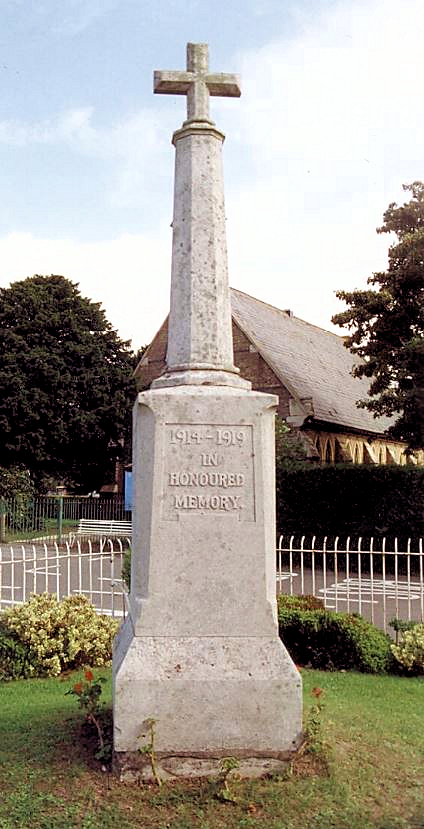War Memorial

The present War Memorial is in the form of a stone Calvary Cross and shaft with a total height of 2.7m mounted on a four-sided stone base measuring 0.8 x 0.8m. Its inscription is in black lettering and was unveiled on 24th May 1921.
There are inscriptions for both the 1914-19 conflict as well as the 1939-45 World War. The first inscription reads: "1914-1919 IN HONOURED MEMORY". The second inscription contains the names of the 17 who fell in the First World War: "Bean, Frederick / Bingham, Reginald A L / Brockman, George P / Culmer, Arthur T / Culver, George S / Dennett, Albert R / Ellen, William T / Howland, Herbert / Howland, William J / Laker, Edwin / Lodge, Ernest J / Lodge, William H / Maxted, Harry / Smith, Frank / Studham, Ernest / Terry, Charles W J / Wheeler, Charles .
The next inscription reads: "TO THOSE WHO FELL IN THE GREAT WAR. IN HONOURED MEMORY OF THOSE WHO FELL IN THE WORLD WAR 1939-1945 VICTOR CHURCH / EDDY FINN / TEDDY HOWLAND / REGGIE STEED"
Further Information:
28 July 1914 – 11 November 1918
Frederick Bean Age: 25: Royal Navy; Reginald A. L. Bingham Age: 21 Gordon Highlanders; George P. Brockman Aged 24; Arthur T. Culmer Age: 20: The Buffs (East Kent Regiment); George S. Culver Age: 31: Northumberland Fusiliers; Albert R. Dennet Age:32 East Surrey Regiment; William T. Ellen Age: 18: The Buffs (East Kent Regiment); Herbert Howland Age: 21: The Buffs (East Kent Regiment); William J. Howland Age: 25: The Royal Engineers; Edwin Laker Age: 19: The Buffs (East Kent Regiment); Ernest J. Lodge Age: 20: Machine Gun Corps (Heavy Branch); Willaim H. Lodge Date of Death: 18/11/1916 The Buffs (East Kent Regiment); Harry Maxted Age: 21: Royal Engineers; Frank Smith Age: 38: The Buffs (East Kent Regiment); Ernest Studham Date of Death: 20/10/1918 The Royal Fusiliers; Charles W.J. Terry Age: 22: Royal Army Medical Corps; Charles Wheeler Died 26 September 1915: The Buffs (East Kent Regiment).
1939 – 1945
Victor Church Died Between 10 May 1940 and 24 January 1941: The Buffs (Royal East Kent Regiment); Eddy Finn died 1942: The Buffs (Royal East Kent Regiment); Teddy Howland died 1940: The Buffs (Royal East Kent Regiment); Reggie Steed.
Britain at War
The military casualties incurred by the UK during the World Wars dwarf anything that has occurred since.
Three times as many British forces died on the first day of the Battle of the Somme (19,240) than have been killed in every combat operation since the end of WWII. Had the Prime Minister read out their names in the House of Commons, as has been done since 2003, it would have taken at least 11 hours. Over the course of the war, 880,000 British forces died, 6% of the adult male population and 12.5% of those serving. The toll on the adult male population meant that the 1921 Census recorded 109 women for every hundred men.
In WWII there were 384,000 soldiers killed in combat, but a higher civilian death toll (70,000, as opposed to 2,000 in WWI), largely due to German bombing raids during the Blitz: 40,000 civilians died in the seven-month period between September 1940 and May 1941, almost half of them in London.
The strength of the British military during the World Wars was boosted greatly by the conscription of civilians. The army reached a peak of 4m soldiers in 1918 and 2.9m in 1945. A more limited form of conscription, known as National Service, lasted until 1963, with the last use of conscripts in combat operations occurring at Suez in 1956.